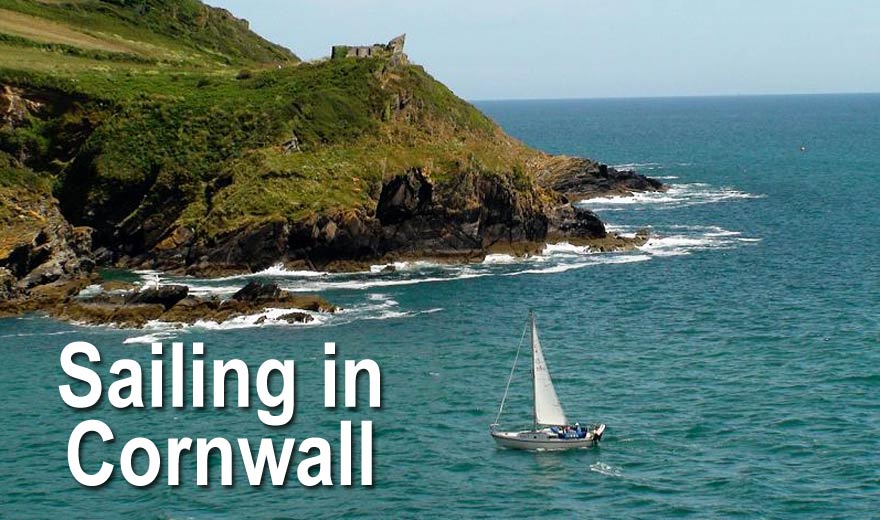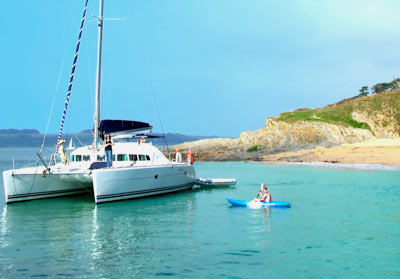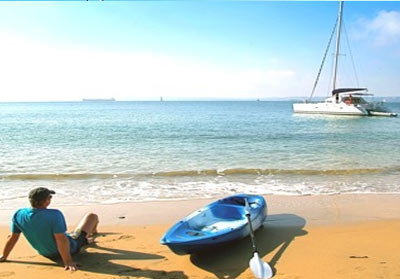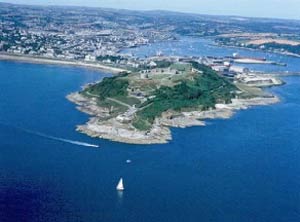Sailing in Cornwall

Sailing - North Cornwall Coast: PADSTOW
| NEWQUAY | PORTREATH
Sailing - Far West Cornwall: ISLES
OF SCILLY, ST MARY'S | ST IVES |
PENZANCE | NEWLYN
Sailing - South Cornwall Coast: PORTHLEVEN
| FALMOUTH | CARRICK
ROADS
Sailing - East Cornwall Coast: MEVAGISSEY
| FOWEY | LOOE
| TORPOINT
Lakes & Reservoirs
THE SOUTH COAST
 |
|
Skippered Yacht Charter - Sailing Cruises on a Luxury Skippered Catamaran Climb aboard for a fantastic day out exploring some of the UK’s most idyllic, sheltered waterways on the south coast of Cornwall, covering the River Fal and Falmouth Bay and Helford River. |
 |
Falmouth
Falmouth is not as old as many of Cornwall's towns and it was not until Sir Walter Raleigh put into the Fal on his return from New Guinea that the expanse of sheltered water in the Carrick Roads became known outside the local area. Before this time it had been used by local fishing boats and, of course, by pirates and smugglers, who knew well the advantages of such a sheltered anchorage.
Truro, 11 miles up the river Fal, and Penryn were both flourishing ports and the proposals for the development of a new port at the mouth of the river were wholly opposed by both towns. However, the objections were overruled and by 1670 the new town of Falmouth had a quay and a rapidly growing maritime trade. In 1688 Falmouth was selected as a Mail Packet Station carrying mail to and from London and the rest of the world.
The port also became popular as the first and last port of call for the big sailing ships of the grain trade and it was only the advent of steamships that stopped Falmouth from growing to be the most important port on the south coast. When at last Falmouth was linked to London and the rest of the country by rail, in 1863, the mail trade had already moved to Southampton and the port of Falmouth was in decline.
By fortuitous chance this decline coincided with the beginning of the holiday travel business and Falmouth, with its striking scenery and mild climate, rapidly became a major centre for tourism, which it has held to this day. The town itself is split into two, with the harbour and town centre on the north side and the beach resort, with hotels, guesthouses and gardens to the south. The long main street of the town runs parallel with the water, and stepped alleys run down to the river giving glimpses of the estuary and the boats. The Maritime Museum is well worth a visit and it features boats moored alongside as well as a land based museum concentrating on the seafaring history of the town. Another historic building of interest is Pendennis Castle, built by Henry VIII as part of the south coast defences to resist invasion by the French. It is now owned by English Heritage and is immaculately preserved.
 Harbour
characteristics
Harbour
characteristics
Beyond Black Rock, which lies slightly to the west of centre of the harbour entrance and is well marked, there are few hazards. Keep an eye open for vessels using the docks, on the port side.
Visitors' Moorings
Visitors' Yacht Haven (172 metres of floating pontoons situated at North Quay): space for about 50 boats of up to 12 metres (40 ft) and up to 1.8 metres draught (6ft). VHF radio: Channels 16 and 12.
Deep water moorings
Space for half a dozen moorings exclusively for the use of visitors, the largest of which is capable of taking yachts or other vessels up to 100 ft in length. These moorings are marked by green buoys and are situated nearest the Falmouth side of the main channel between Greenbank Quay and Prince of Wales Pier. These moorings allocated on arrival by contacting the Harbour Patrol or Harbour Office.
Falmouth Yacht Marina (pontoons): proportion of 230 berths reserved for visitors. Up to 70ft; 10ft draught. Off North Parade, Falmouth. Contact Falmouth Yacht Marina; VHF channel 37 (m). Grove Place Boat Park, a boat park where small boats may be launched, recovered and stowed ashore.
Pilotage
Only navigational problem is the Black Rock virtually in the middle of the Fal Estuary entrance. It is marked by a black conical beacon topped by two spheres, erected on the rock, Though the beacon is unlit, the nearby Black Rock Buoy is lit and should be left to port when entering the harbour.
Falmouth Harbour is easily entered at night.
 |
|
Promoting
your business on Cornwall Online |
|
Cornwall
Online is a trading name of ITS WEB DESIGN - COL DIRECT
Cornwall Online Website by ITS WEB DESIGN - COL DIRECT. Tel 01579 557343 Please ensure that you confirm all details with the Advertiser before Booking We recommend that you take out Holiday Insurance on ALL Bookings |